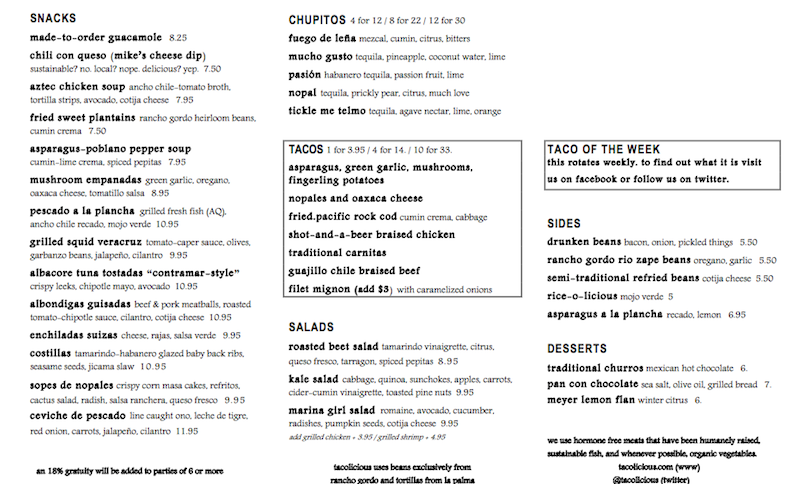On Wednesday the Stanford QUEST group (queer staff and faculty) had our monthly happy hour, this time at Tacolicious in Palo Alto, a Mexican restaurant that not long ago replaced the Indian fusion restaurant Mantra (which succeeded the Japanese fusion restaurant Higashi West, which succeeded Old Uncle Gaylord’s Kosher Ice Cream Parlour, which I remember fondly from 30 years ago). (Restaurant turnover in Palo Alto is scandalous.)
Tacolicious is not just a taco place, but something trendier and more inventive. And crowded. And very noisy (probably by design, since the conversion from Mantra involved tearing out the entire interior of the restaurant and installing lots of reflective surfaces; noisy makes a restaurant “hot”).
This posting is going to be about the restaurant’s name. But first more on the place itself.
The Palo Alto restaurant is the newest of three branches of the restaurant. A map and some ad copy from the Tacolicious website:
Every Tacolicious location has its own personality. At our original location in the Marina, look up: the four of spades is curiously stuck to the ceiling. (Inquire within for this story of love and magic.) In the Mission, where a sunny enclosed deck is the perfect place to enjoy a cold margarita, we pay homage to Lalo, lime squeezer extraordinaire, with a vintage juicer collection. And in Palo Alto, the massive Paul Madonna mural is so stunning that you might feel you’ve been whisked away to Atotonilco in Jalisco, Mexico, home of one of our favorite tequila distilleries.
Each location has its own menu. For Palo Alto:
(Click on the menu to embiggen it.)
The snacks are very good. The squid, for example, is wonderfully tender, not at all rubber-band-like. And there’s a large selection of things to drink. (Note the chupitos on the menu — alcholic drinks traditionally served in shot glasses. The Tickle Me Telmo is linguistically notable; the name playfully combines the children’s toy Tickle Me Elmo with the liquor tequila.)
The QUEST folks were pleased with the food and entertained by the decor, but less happy with the noise, which made it hard for us to talk.
In case you haven’t experienced the taco — not all my readers are geographically or culturally close to Mexico — here’s the short version from Wikipedia, plus a photo of a varied set of tacos:
A taco … is a traditional Mexican dish composed of a corn or wheat tortilla folded or rolled around a filling. A taco can be made with a variety of fillings, including beef, pork, chicken, seafood, vegetables and cheese, allowing for great versatility and variety. A taco is generally eaten without utensils and is often accompanied by garnishes such as salsa, avocado or guacamole, cilantro, tomatoes, minced meat, onions and lettuce.
Etymology: According to the Real Academia Española, publisher of Diccionario de la Lengua Española, the word taco describes a typical Mexican dish of a maize tortilla folded around food (“Tortilla de maíz enrollada con algún alimento dentro, típica de México”). The original sense of the word is of a “plug” or “wad” used to fill a hole (“Pedazo de madera, metal u otra materia, corto y grueso, que se encaja en algún hueco”).
… The taco predates the arrival of Europeans in Mexico.
Now, the name Tacolicious, which looks like a straightforward portmanteau of taco and delicious — except that -licious has developed a life of its own as a libfix playfully denoting or connoting excellence. From a 2009 Language Log posting of mine on “Liciousness:
On her Fritinancy blog, Nancy Friedman has recently posted (under the heading “the tastiest suffix”) an inventory of playful -licious brand names and brand descriptors, from Bake-a-Licious through Zombielicious. The -licious words come up every so often on Language Log, starting with 2006 postings by me (here) and Ben Zimmer (here), and going on with additional examples in 2007 (here) and this year (here).
From my 2006 posting:
there are cites of babelicious and blackalicious from 1992, which seems to have been a particularly morpholicious year. The larger point is that -Vlicious words are likely to have been invented independently on many occasions, as portmanteaus, leading eventually to the emergence of the jocular suffix. Some innovations in language have no clear single moment of creation, but arise as natural re-workings of the material of a language, by many different hands.
More recently, on this blog I’ve looked at Zippylicious names (names that Zippy the Pinhead or Bill Griffith find especially savory) — here and here – and on men who are scruffalicious (here) or scuffilicious (here). And on AZBlogX, some material on men described as twinkalicious (with various spellings); more G-rated material on such men will come in this blog.



